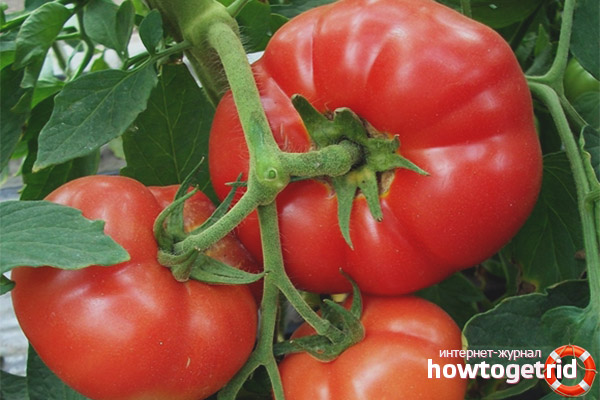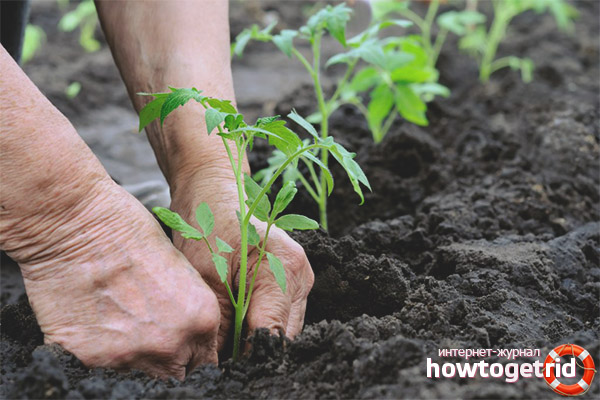The content of the article
Tomatoes come in different varieties, shapes and colors. One of them, with pink berries, is called first-grader. It is known throughout Russia and is cultivated in the northern cold regions, and in the warm south. It is grown both on the street and in greenhouses. Tomatoes of this variety are considered salad, but are also used for canning.
Description of the bushes
- There are few leaves on the plant, it is stunted - 70-104 centimeters.
- The stalk is dense and wide, there are many branches with dark green leaves on it.
- Yellow flower tassels form around the sixth leaf.
- Ripening period is 93-107 days after the appearance of sprouts.
- Productivity is high - 5-6 kilograms of tomatoes from the bush.
Fruit
- Flat-rounded.
- The pulp is medium density.
- The ripe fruit is defiantly bright.
- The average weight of 150-210 grams.
- The fruit has a lot of sugar, so the taste of tomato is sweet.
- Tomatoes are saturated with lycopene - this red pigment strengthens the immune system.
Seedlings
Preparation
Planting of seeds is carried out in late February - early March. The soil is taken either in a store or prepared independently: the soil is mixed in equal parts with humus and disinfected by calcination in an oven. Or watered with a manganese solution. So that the seeds germinate well, it is recommended to wrap them for 2 days in a cloth moistened with water.
The earth needs to be filled in containers, the seeds are placed at a distance of 2 centimeters and sprinkled on top with peat.
Care
Seedlings develop well if the following conditions are met:
- Maintain a constant daytime temperature of 21-27 degrees, night - 16-18 degrees.
- Constantly watered with settled water at room temperature, not allowing the soil to dry.
- Ventilate the room.
- Provide sprouts with light for at least 14-15 hours a day using either fluorescent or phytolamps.
When the second leaf appears, the seedlings dive. That is, each sprout is planted in a separate container filled with the same soil.
20-25 days before planting, seedlings are hardened at the site. For this, the containers are taken outside, leaving under the sun for a couple of hours, each time increasing the time. This procedure will accustom plants to their natural habitat.
When the sprouts reach a height of 30 centimeters, they are planted on the site. By this time, the tomatoes have developed a root system and there are 6 leaves.
Disembarkation
In the warmer southern regions, first-graders are planted in open ground, and in cooler northern regions, in greenhouses. On the street, tomatoes are placed at a distance of 40 centimeters from each other, making the distance between the beds 50 centimeters. In the greenhouse, it is better to plant them in a checkerboard pattern. With this arrangement, the plants will be fully illuminated, and it will be easier to take care of them.
Planting is done like this: sprouts together with the ground are installed in the hole, compact the ground and well watered. Within a week and a half, the sprouts adapt to a new life, at this time they should not be touched - neither watering nor feeding.
Care
With good care, the first-grader pleases with a plentiful harvest. Care consists in watering and timely top dressing. In order not to have too thick thickets, pinching the stepsons is carried out.
Watering
Tomatoes are watered in the morning and evening hours. After this, the greenhouse is ventilated, and the soil is loosened so that moisture is better absorbed.
Watering frequency:
- Before blooming - 1 time per week, each bush is spilled with 4 liters of water.
- During flowering - every 3 days, 2 liters of water per bush.
- During fruiting - once a week at least 3 liters per bush.
If the humidity is high, growth will slow down and the development of the fungus will begin. And when tomatoes ripen, then excess moisture leads to cracking of berries. If moisture is not enough - it is easy to determine by the leaves: they curl and turn yellow.
Top dressing
Tomatoes are fed 3 or 4 times. Root dressing is usually used, introducing organic fertilizers (mullein, bird droppings) and potassium phosphorus into the soil. You can also fertilize tomatoes by spraying.
Formation
Bushes of the Pervoklashka variety need formation and pinching. Supports are placed under the bushes so that the formation of the stem passes without deformation. The poles are usually made of wood or metal sticks.
Storage
It is best to remove the tomatoes from the bush before they reach full maturity. Otherwise, there is a chance that the fetus will crack and cannot be stored for long. And whole berries are stored for a long time - more than a month, especially if they are placed in a dry place with a temperature of no higher than 13-15 degrees.
Video: folk remedies for feeding tomato











Submit